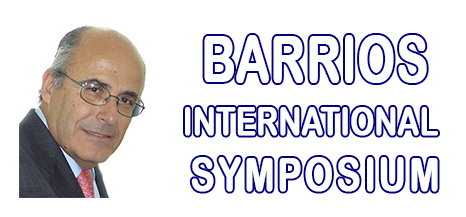List of Accepted Abstracts As of 15/12/2025: (Alphabetical Order)
Barrios Intl. Symp on Sustainable Non-ferrous Smelting and Hydro/Electrochemical Processing
Dodds Intl Symp: on Sustainable Energy Production: Fossil; Renewables; Nuclear; Waste handling , processing, and storage for all energy production technologies; Energy conservation
Gaune-Escard Intl Symp: on Sustainable Molten Salt and Ionic Liquid Processing
Goodall Intl. Symp. on Sustainability of World Ecosystems in Anthropocene Era
Lotter Intl Symp. on Sustainable Mineral Processing: Principles, Technologies and Industrial Practice
Marquis Intl. Symp. on New and Advanced Materials and Technologies for Energy, Environment and Sustainable Development
Intl. Symp. on Advanced Sustainable Iron and Steel Making
Intl. Symp. on Sustainable Metals & Alloys Processing
Intl. Symp. on Sustainable Aluminum Extraction and Processing
Intl. Symp. on Sustainable Secondary Battery Manufacturing and Recycling
Intl. Symp. on Multiscale Material Mechanics and Multiphysics and Sustainable Applications
Intl. Symp. on Sustainable Mathematics Applications
Intl. Symp. on Sustainable Surface and Interface Engineering: Coatings for Extreme Environments
Intl. Symp. on Composite, Ceramic and Nano Materials Processing, Characterization and Applications
Intl. Symp. on Environmental, Health, Policy, Legal, Management and Social Issues Related to Metals, Materials and Mineral Processing
Intl. Symp. on Sustainable Mining Operations
Intl. Symp. on Synthesis and Properties of Nanomaterials for Future Energy Demands
Intl. Symp. on Rare Earth and Platinum Group Metals: Managing and Processing
Intl. Symp. on Sustainable Materials Recycling Processes and Products
Intl. Symp. Surfaces and Interfaces of Sustainable, Advanced Materials (SISAM)
Summit Plenary
INTL. SYMP. ON SUSTAINABLE SURFACE AND INTERFACE ENGINEERING: COATINGS FOR EXTREME ENVIRONMENTSTo be Updated with new approved abstracts Effect of laser shock peening (LSP) on tribological performance hot work tool steel
Sachin
Patil1; Valmik Bhawar2; Prakash Kattire2; Sandeep Thakare3; P.p. Date2; 0;
1BHARAT FORGE LTD,PUNE, PUNE, India; 2, , ; 3BHARAT FORGE LIMITED, pune, India;
Type of Paper: Invited
Type of Presentation: Oral
Id Paper: 212
Topic: 19Laser shock peening (LSP) is surface enhancement technology used to improve fatigue life. This paper focused on to study the effect of laser peening on micro-structural and mechanical properties of AISI L6 hot work tool steel. Laser shock peening treatment was performed on these tool steel specimens by using laser with 1.6 J energy and 2 Hz frequency. X-ray stress analysis, micro-hardness testing and micro-structural analysis were performed to characterize these laser peened specimens. In addition, pin on disk wear testing were executed to recognize wear and fatigue behavior of this laser peened tool steels. It was observed that along with deep compressive residual stress generation, laser shock peening also induces work hardening effect which are responsible for significant improvement in fatigue and wear performance of this tool steel.
Keywords: Aircraft; Coatings; Corrosion; Surface; Waste; Wear;
Enhancing Absorption of Solar Cell Thin-film Materials by Excitation of Plasmon Resonances in Noble-metal Nanoparticles; Example of Perovskites
Krystyna
Kolwas1; Anastasiya Derkachova1;
1INSTITUTE OF PHYSICS, POLISH ACADEMY OF SCIENCES, Warsaw, Poland;
Type of Paper: Regular
Type of Presentation: Oral
Id Paper: 260
Topic: 19In the past few years, the photovoltaic field has experienced an extremely dynamic increase due to the development of perovskite-based photovoltaic devices that are expected to be the next generation solar cells due to relatively high power conversion efficiencies, long carrier lifetimes, and a significant defect tolerance for solution-processed polycrystalline films. However, absorption by perovskites (as well as by other photovoltaic materials) of solar radiation at longer wavelengths is not optimal.
An admixture of metal nanoparticles and excitation of localized surface plasmons in these nanoparticles could establish a new route for an improvement of the performance of such devices. Excitations of plasmons give rise to a variety of effects tuned by their size and shape which result in strong electromagnetic field concentration and enhancement that occurs in the vicinity of the metal surface. The strong interaction of such nanoparticles with light makes them efficient receiving or/and scattering optical nanoantennas. Using the tools of electrodynamics, we predict a strong red-shift in the spectral activity of gold and silver nanospheres and modification (negative or positive) of white and solar light harvesting in the film of perovskite host caused by centrally distributed plasmonic nanospheres. The enhancement of absorption in perovskite host is proven to be possible for photons with energies close to or smaller than the energy bandgap in perovskite, with the final effect depending on the diameter of nanospheres, their concentration, and kind of metal. From the electronic band structure point of view, the predicted strengthening of absorption can be interpreted as the effect of semiconductor doping with metals resulting in increased photocurrent.
We introduced several measures of absorption modification, which account for the gain and depletion of absorption in the host (perovskite thin film) versus nanoparticles size. The model can be applied to any film of absorbing materials containing any optically uncoupled, centrally distributed nanospheres.
The most important finding is the predicted reinforcement of light harvesting in the perovskite host in the long wavelength spectral range, where, when undoped, it cannot absorb radiation. The reinforcement effect depends on the diameter of nanospheres, their concentration, and kind of metal.
The predicted enhancement of light harvesting by incorporation of metal nanoparticles can be understood as the effect of semiconductor doping, which results in a behavior more similar to a conductor�s one with all consequences for the new allowed energy levels (bands) and boosting photocurrent. The predicted enhancement of light harvesting by incorporation of metal nanoparticles can be understood as the effect of semiconductor doping, which results in a behavior more similar to a conductor�s one with all consequences for the new allowed energy levels (bands) and boosting photocurrent. Our modeling opens the new way in understanding and predicting the enhancement of solar conversion efficiency in photovoltaic materials.
Keywords: Absorption; Energy; Nanomaterials; Nanoparticles; Photovoltaic; Radiation; Solar; Spectroscopy;
SiO2 + Y2O3 Thermal Barrier Coatings On Ceramic Substrates
Pawel
Rokicki1; Marek Goral1; Willy Kunz2; Markus Loeffer3; Andre Clausner2; Slawomir Kotowski4; Andrzej Nowotnik4; Ehrenfried Zschech5; Elżbieta Bąk1;
1RZESZOW UNIVERSITY OF TECHNOLOGY, RESEARCH AND DEVELOPMENT LABORATORY FOR AEROSPACE MATERIALS, Rzeszow, Poland; 2FRAUNHOFER-INSTITUT FUR KERAMISCHE TECHNOLOGIEN UND SYSTEME IKTS, Dresden, Germany (Deutschland); 3TECHNISCHE UNIVERSITAT DRESDEN, Dresden, Germany (Deutschland); 4RZESZOW UNIVERSITY OF TECHNOLOGY, Rzeszow, Poland; 5FRAUNHOFER INSTITUTE FOR CERAMIC TECHNOLOGIES AND SYSTEMS IKTS, Dresden, Germany (Deutschland);
Type of Paper: Regular
Type of Presentation: Oral
Id Paper: 338
Topic: 19Ceramic matrix composites are potential future innovative materials for high temperature application in gas turbines and aviation industry. Mechanical properties at elevated temperature reaching up to 1500°C make these group of materials suitable for increased efficiency and lower emission of the aircraft engine. However, corrosion resistance is still an issue, especially in meaning of water vapour. Moreover, thermal insulation is important for oxide ceramic matrix composites due to their low temperature limit. That is why new protective coatings in form of TBCs are needed to increase the potential of these materials. The research conducted within the international project funded from the European Union concerns development of the Atmospheric Plasma Spraying method in meaning of obtaining new material system based on ceramic matrix composite. The paper is focused on the first stage of preparation of the process. The aim is to develop the method of APS with YSZ on the ceramic substrate. The results obtained within the study will be used for development of the process parameters for advanced ceramic matrix composites. The study focuses on methodology that was applied in the research as well as the literature analysis.
Keywords: Atmospheric Plasma Spraying, Silicon Oxide, Yttrium Oxide, Silicon Nitride, TBC
|







